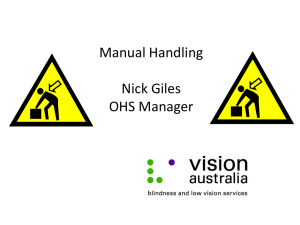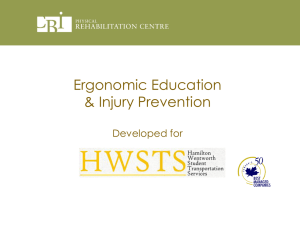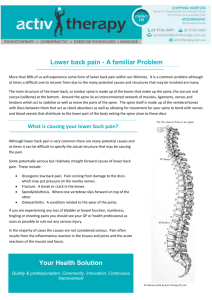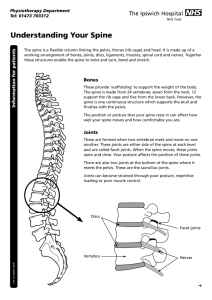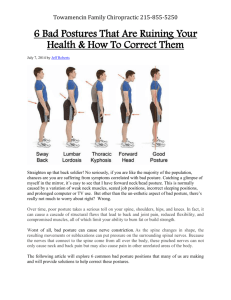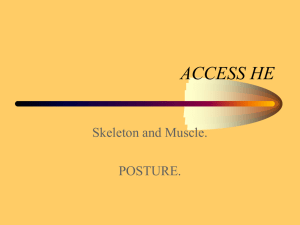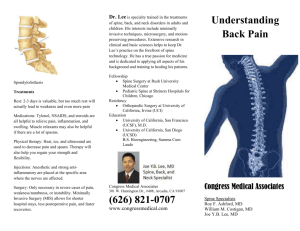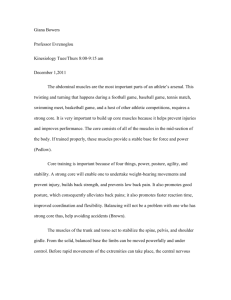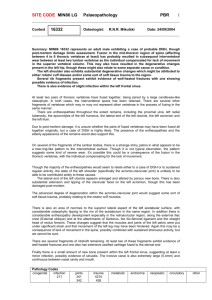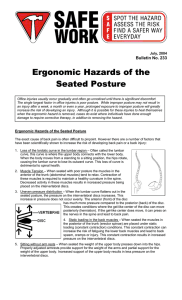BACK CARE
advertisement
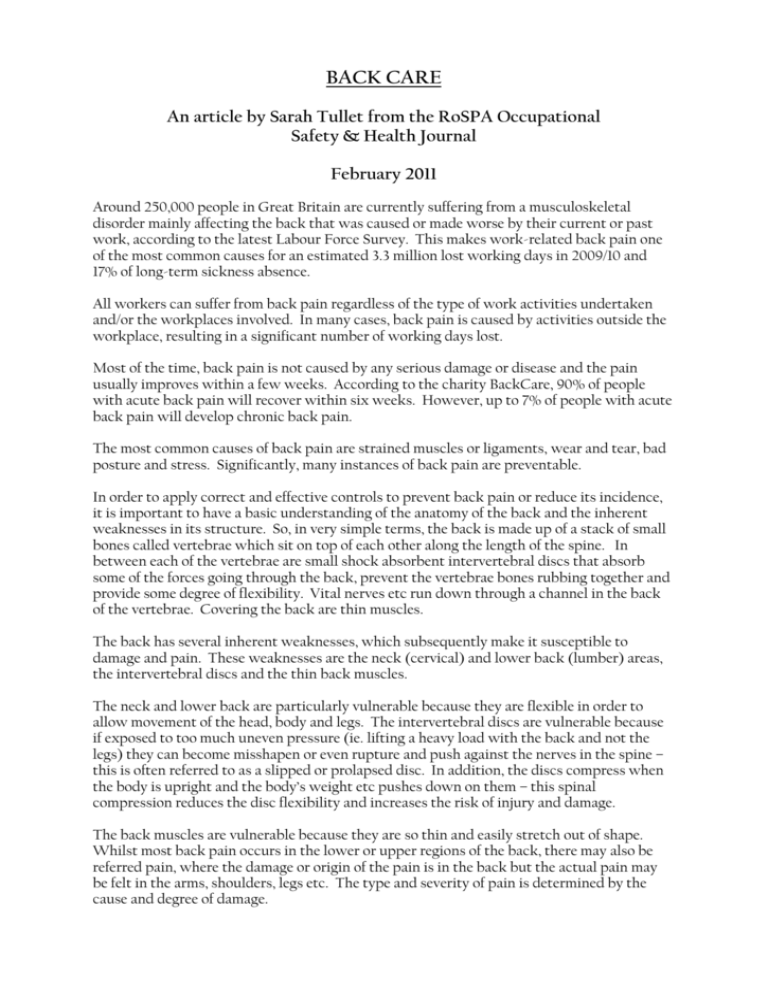
BACK CARE An article by Sarah Tullet from the RoSPA Occupational Safety & Health Journal February 2011 Around 250,000 people in Great Britain are currently suffering from a musculoskeletal disorder mainly affecting the back that was caused or made worse by their current or past work, according to the latest Labour Force Survey. This makes work-related back pain one of the most common causes for an estimated 3.3 million lost working days in 2009/10 and 17% of long-term sickness absence. All workers can suffer from back pain regardless of the type of work activities undertaken and/or the workplaces involved. In many cases, back pain is caused by activities outside the workplace, resulting in a significant number of working days lost. Most of the time, back pain is not caused by any serious damage or disease and the pain usually improves within a few weeks. According to the charity BackCare, 90% of people with acute back pain will recover within six weeks. However, up to 7% of people with acute back pain will develop chronic back pain. The most common causes of back pain are strained muscles or ligaments, wear and tear, bad posture and stress. Significantly, many instances of back pain are preventable. In order to apply correct and effective controls to prevent back pain or reduce its incidence, it is important to have a basic understanding of the anatomy of the back and the inherent weaknesses in its structure. So, in very simple terms, the back is made up of a stack of small bones called vertebrae which sit on top of each other along the length of the spine. In between each of the vertebrae are small shock absorbent intervertebral discs that absorb some of the forces going through the back, prevent the vertebrae bones rubbing together and provide some degree of flexibility. Vital nerves etc run down through a channel in the back of the vertebrae. Covering the back are thin muscles. The back has several inherent weaknesses, which subsequently make it susceptible to damage and pain. These weaknesses are the neck (cervical) and lower back (lumber) areas, the intervertebral discs and the thin back muscles. The neck and lower back are particularly vulnerable because they are flexible in order to allow movement of the head, body and legs. The intervertebral discs are vulnerable because if exposed to too much uneven pressure (ie. lifting a heavy load with the back and not the legs) they can become misshapen or even rupture and push against the nerves in the spine – this is often referred to as a slipped or prolapsed disc. In addition, the discs compress when the body is upright and the body’s weight etc pushes down on them – this spinal compression reduces the disc flexibility and increases the risk of injury and damage. The back muscles are vulnerable because they are so thin and easily stretch out of shape. Whilst most back pain occurs in the lower or upper regions of the back, there may also be referred pain, where the damage or origin of the pain is in the back but the actual pain may be felt in the arms, shoulders, legs etc. The type and severity of pain is determined by the cause and degree of damage. Causes Work related back pain is commonly associated with moving and handling, especially heavy loads; however there are many other work-related causes including: Bending and twisting, especially while carrying out a moving and handling task Poor, awkward and/or prolonged postures, both standing and sitting, eg. working on a production line, sitting in a car for long periods Stretching and/or bending A further consideration, which is becoming more prevalent, is managing the back health of mobile workers. Sitting for long periods driving and additionally using the car as an office, ie. using the laptop by twisting towards the passenger seat or perched on the drivers lap against the steering wheel are all high risk activities if not effectively controlled. In addition, there are also contributing factors that may make a back injury more likely and/or severe such as: Inappropriate work equipment Inadequately set up work equipment Rushing/taking short cuts Not ensuring the back muscles etc are properly warmed up before undertaking strenuous activities Fatigue, eg. after a long shift Various health conditions, such as osteoporosis, arthritis, rheumatism etc Exiting weakness in the back or existing injury Lack of proper and effective back support Controls Before control measures can be introduced in the workplace a risk assessment of all work activities should be undertaken to identify the activities where back injury is possible. Accident reports may give an indication as to where such problems are occurring, as may ‘body mapping’. Body mapping is a way of determining where ill health issues are occurring by identifying the areas of the body that are injured or where pain occurs against the associated work activities (see www.hazards.org/diyresearch/#mapping). The underlying basis in preventing and managing back pain though is the ergonomic principle of “fitting the task to the worker, not the worker to the task”. This means adapting the work equipment and/or workplace, so far as is reasonably practicable, to suit each worker. In practice, the majority of workers will be adequately protected by generic measures, so the emphasis should be on identifying and making adjustments for those workers who require different and/or additional adjustments etc. In addition, encouraging good posture while the work task is being undertaken, ie. keeping everything in line through the spine, is an important principle. Any deviation away from good posture will cause extra and/or uneven strain on parts of the back, eg. bending for long periods or constantly looking up/down from notes on a desk when using a computer which will eventually result in neck pain. An important aspect of ensuring good posture is ensuring that work equipment is as flexible and adjustable as possible. Equipment that provides a range of possible adjustments will allow a greater number of workers to work safely and comfortably – it is definitely not a vase of one size fits all. Of course getting the best use out of the equipment is dependent on the workers using it knowing how to make adjustments and understanding what they are supposed to be achieving and why. So suitable training is vital. Dynamic risk assessments and training to understand the risk assessment process and necessary controls are also all important factors. In addition, allowing workers to be involved in planning their own workloads and work routines to include regular breaks and changes in tasks is also a key control. Workers also have to take some personal responsibility in looking after their backs. This includes using equipment provided by their employer properly, in accordance with any training. It is also up to the worker to be aware and take account of any existing back “niggles” they may have which may increase the likelihood and/or severity of a back injury, eg. from accumulative tiredness/fatigue during heavy work periods or as a result of preexisting health conditions. If relevant, these should be flagged up to their employer so appropriate actions can be taken. Workers can also help themselves by ensuring they gently exercise/warm up back muscles before undertaking strenuous activities, so that they are at maximum flexibility and less likely to be damaged, and by ensuring they take regular breaks and do not maintain static postures for long periods. When workers do suffer back pain, particularly if they have time off, it is important that their absence period and return to work are effectively managed. This may mean the employer following advice provided by a GP on the worker’s fit note or recommendations from the company’s occupational health adviser or any changes in duties etc, eg. returning on light duties and/or shorter hours etc for a determined period. Coping with back pain In the early stages: Rest may not help. Your back is designed for movement so the sooner you start doing your ordinary activities the better Use pain killers, heat or cold applied to the sore area may help A short course of manipulation can help relieve back pain for some, if done by a qualified osteopath, physiotherapist or chiropractor Next steps: Steadily increase your level of activity Do a little bit more each day if the pain has been restricting your movement Do not stay in one position for too long Get up and stretch regularly Move about and take some walks, building up your activity as you get stronger Stay at work if you can to keep active and recover from the pain. If you have a lot of lifting or other risk factors in your job, talk to your supervisor or boss and tell them about tasks that will be difficult to begin with Even if the pain is particularly severe and you are off work, you can still try to do most daily activities or hobbies Don’t do one thing for too long. Keep changing your activities so that you are changing position and moving around from time to time Advice and information www.hse.gov.uk/msd/backpain/index.htm www.nhs.uk/Livewell/workplacehealth/Pages/backpainatwork.aspx www.backcare.org.uk www.tsoshop.co.uk/bookstore.asp?FO=1160007&DI=346223 www.bohrf.org.uk/downloads/backleaf.pdf
